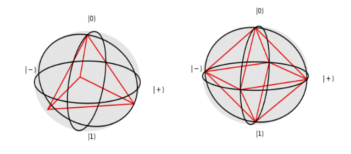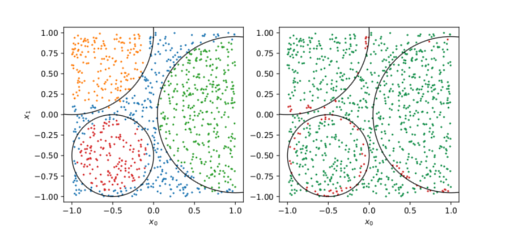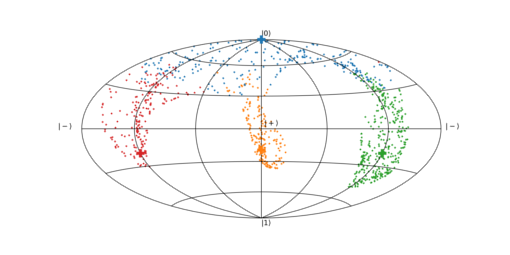Data reuploading for a universal quantum classifier#
Code at: https://github.com/qiboteam/qibo/tree/master/examples/reuploading_classifier.
Based in the paper Quantum 4, 226 (2020).. In this README.md file you can see a short
set of instructions for the usage of the example.
What this example does?#
This example provides a variational algorithm for classifying classical data using only one qubit. There are two main ideas in this work. The general idea is to create a single-qubit circuit where several different unitary gates are aplied
Re-uploading: create a single-qubit circuit where several different unitary gates are applied. The exact gate depends on the point to classify and on a set of parameters found by learning the classes of a training set.
Separating classes: the Bloch sphere has plenty of room on its surface, thus it is possible to define a set of target states representing different labels. These states are chosen in such a way that they are maximally orthogonal among them.
The re-uploading works in circuits like the one below. For this example, we will classify datasets with dimension 2. The exact dependency of the unitary gates was chosen to be Rz(w x1 + b)Ry(v x0 + a), although other Ansätze are also useful. Notice that the Ry gates are connected to the x0 coordinate, while Rz gates are related to x1. Rotations around two different axis suffice to generate enough representativity to solve the problem.

The goal is to find a set of parameters such that all points belonging to the same class are driven to be as close as possible to a target state that depends on the class. These target states are chosen to be as orthogonal as possible. For binary classification, the states |0> and |1> are enough. Three classes require an equilateral triangle circumscribed to an equator. More classes require polyhedra. For 4, 6, 8, 12 and 20 labels, platonic polyhedra may be used.

Usage#
In this example there are only three files
datasets.pycontains the classical functions that create the datasets of the experiment and their representations.qlassifier.pyencodes all quantum circuits and procedures needed to run the circuits.main.pyis the file calling all other functions. The action of every line of code is commented in the source code.
The parameters to be fixed for a run of the experiment are
dataset: problem to solve, to choose between
['circle', '3_circles', 'square', '4_squares', 'crown', 'tricrown', 'wavy_lines']layers: layers of the classifier
Every time the main.py is run, it checks whether there is a solution to that particular problem. If it has been
already computed, then no minimization is done, only the results are saved. Otherwise, minimization is performed.
A collection of solved examples is saved in saved_parameters.pkl. It is not mandatory, but it may save some time.
Results#
Two different results are presented in this example. First, it is shown the labels that the algorithm guesses for every point (left), together with which ones are right and wrong (right). This result is useful for quantifying the accuracy of the classifier. The colors represent the guessed labels, while the area corresponding to each class is delimited with a black line.

The second result represents the distribution of the test points on the Bloch sphere. In this case, the colors represent the actual labels of the points. This plot is useful to see how the points in the same class get close to the target state.

Every time the main.py file is run, both results are saved in the folder
results/[name of the problem]/[number of layers]_layers. The repository includes the solution
for all problems with 10 layers.